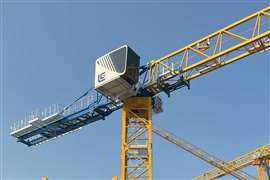Making waves
11 August 2008

Sparrows Offshore Services, based in Aberdeen, Scotland, introduced its Integra Deck-Operating Safety Program in January 2007. The scheme provides training onsite, rather than in onshore classrooms, and was initially rolled out on Shell’s Northern platforms in the UK sector of the North Sea where Sparrows has a crane management contract.
Brian Smith, Sparrows contract manager for the Shell managed contract, says the scheme has had a positive effect on safety performance “Before it started we had about 15 incidents involving cranes, with two high potential incidents. The incidents were reduced by 56% in the first full year following implementation of the programme, with high potential incidents reduced by 100%.”
The offshore crane contractor was alerted to the need for new safety initiatives following incidents in which cranes came into contact with other platform structures.
“That was not due to machine failure, but to human error where the crane banksman or, in some instances, the crane driver, were not paying attention or not being aware of the hazards when working in close proximity to surrounding structures.
“There were also issues with the level of competency and experience of the deck crews. Some had been working there for many years but did not necessarily have the knowledge of high risk situations when working with cranes, others were relatively new to the industry and need formal training on best practices and hazard awareness associated with crane operations.”
Best practices
“The banksman should never be in contact with the load and should be watching what the load is doing and what the boom is doing in relation to its surroundings. This should be done through good communications, typically, radio for offshore but, sometimes, hand signals. We found this procedure was being breached in many locations either due to misunderstanding of best practices or never having been told the basics correctly. The load handler and banksman would be getting involved with the lift and taking their eye off the boom, which, in some instances, would result in the boom coming into contact with other structures, resulting in a high potential incident. Equipment such as floodlights or handrail sections were being dislodged during this collision, leading to near misses where personnel on the decks were exposed to falling objects.
Sparrows has an internal training scheme for all crane operators where they undertake bi-annual competency assessments to ensure they are familiar with safety standards, best practices and the machinery they are operating. Now that Integra is also in place this give all deck crews a means to achieve similar competency standards.
“It’s a training programme with a difference. We wanted to set up something different. Rather than bringing the guys in and giving them the same old message, we thought we would take it to them where they work.
“Coaches go into the field and observe the actual crane operation. They then discuss the good points and the bad points of what was seen, if a deck hand or a member of the deck crew has any questions, they can do it real time, rather than trying to explain something in an onshore setting. For example, that a particular platform is different because it has restricted deck space or, perhaps, some tight landing areas. What we are trying to achieve with the programme is a common approach with standard documents and procedures to ensure best practices are shared and implemented and, in turn, followed for all 13 platforms. At the outset of the programme the coaches would travel between platforms and find that procedures were being done differently from one platform to another. This, in turn, added to the confusion for parties who travelled between installations.”
Personal injury
Due to the success of the Integra programme, other areas of the Sparrows organization are taking the principles and delivering them to other clients at other Sparrows managed sites around the world.
Smith continues, “Lifting operations on offshore platforms has the potential for personnel injury and equipment damage and, for Sparrows, safety during these operations is paramount in achieving its objectives. We have the same safety standards in the mature market of the North Sea as well as our other operations in the Middle East or Caspian Sea, for example.”
However, Smith is keen to point out that while offshore lifting is potentially dangerous, the industry is a safe place to work.
“It is high profile because if something goes wrong with a lifting operation there is a high potential for several personnel to be hurt. To mitigate this risk there are numerous safety initiatives going on all the time to ensure awareness of the task, competency of the people involved and integrity of the equipment being used.”
Sparrows also offers annual safety away-days for all its field staff (known as the flying squad). Personnel from different disciplines attend. A number of safety themes are presented at these away days to cover the issues faced in the field. A recent one was a hand protection course. Hand injuries are common in the industry, explains Smith, generally through carelessness or failure to wear protective clothing.
Maintenance
The rarity of mechanical failure in the offshore lifting sector in the North Sea is due to regular and stringent maintenance and checks, explains Smith. Sparrows uses its Failure Mode Event Criticality Analysis to risk-assess a machine to ensure maintenance is effected in the correct areas at the correct frequency.
“Specialists will look at different disciplines of a machine; electrical, hydraulic, mechanical parts, ropes and structure. They will come up with safety critical elements and that is how we determine the structure for maintenance. For example, if you know something is going to fail in four years then you will change it in two.”
Smith continues, “You have obviously also got European standards which are quite onerous. All cranes go through that process to ensure whatever weaknesses they have, they are maintained accordingly.”
Certain elements of the onshore lifting industry would be wise to take notice of the safety training techniques used by its offshore counterparts.



